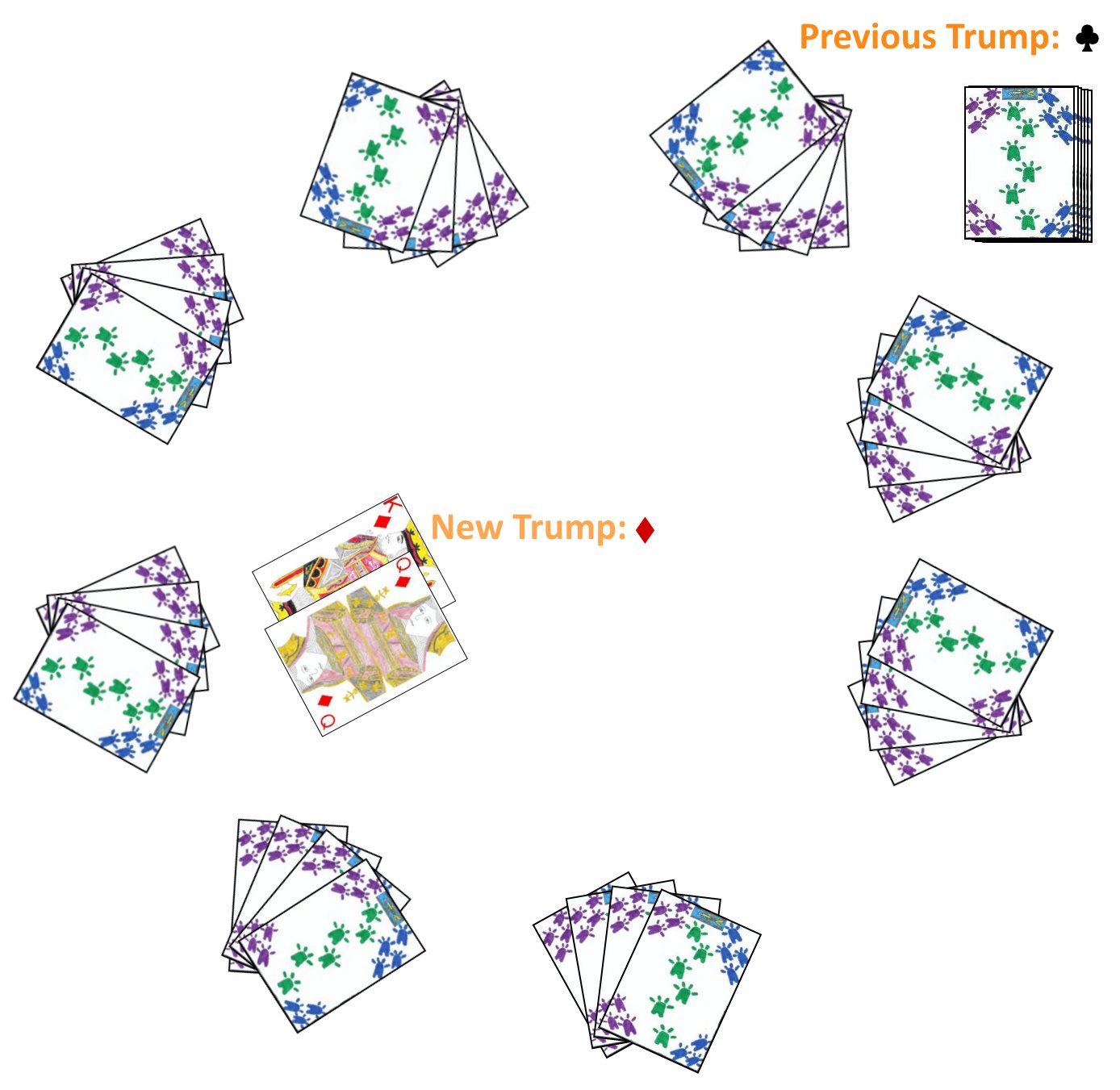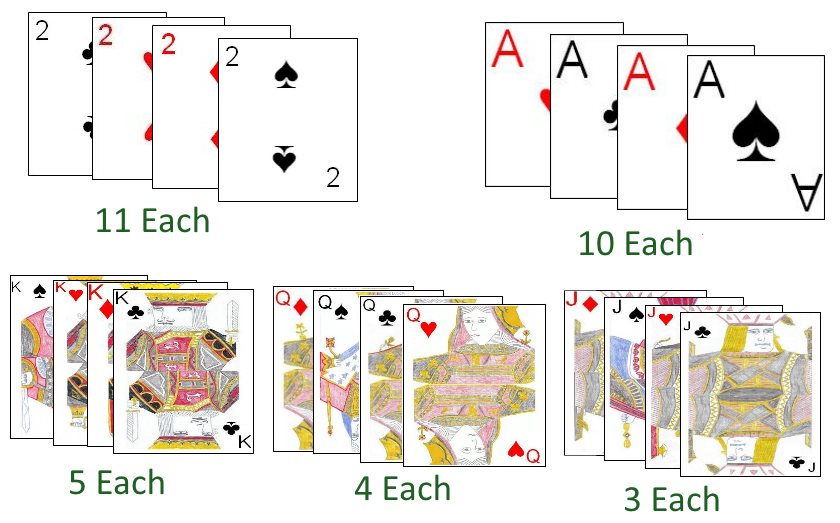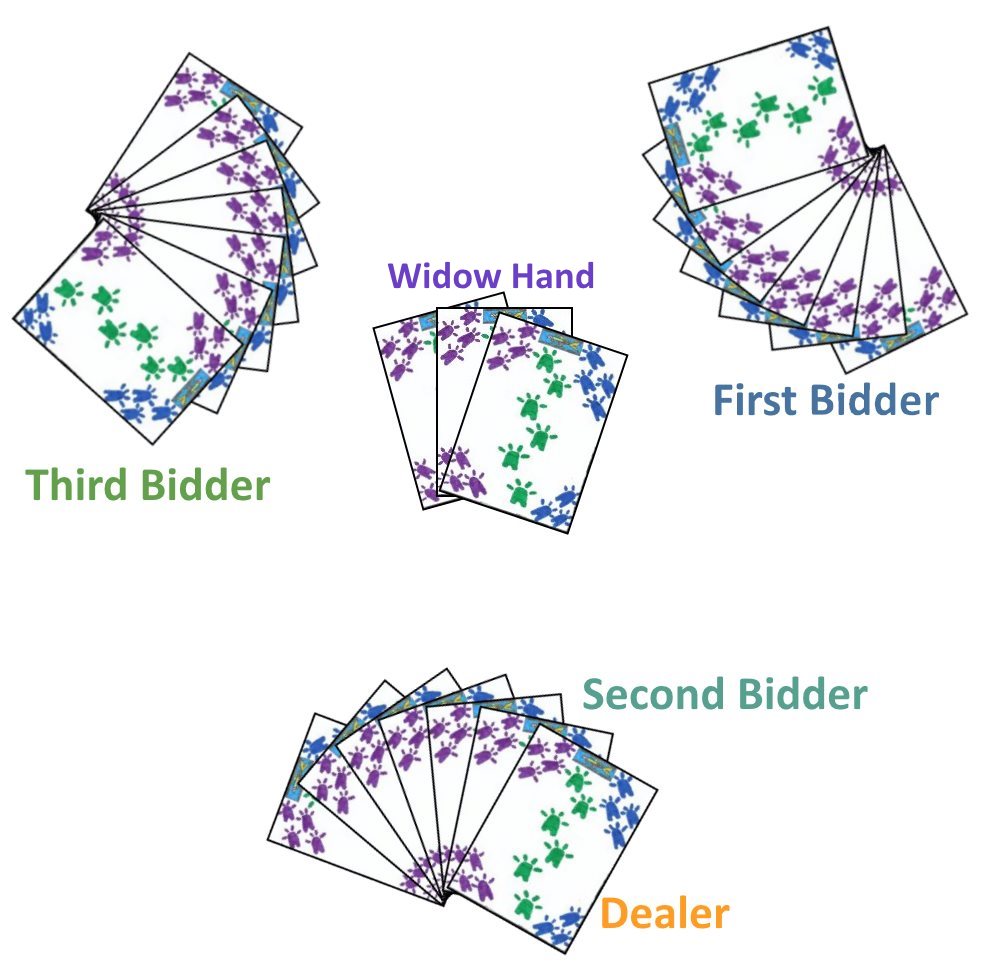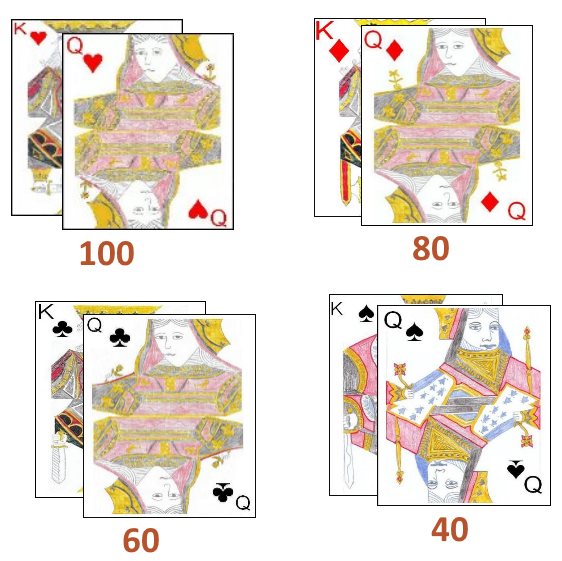Although this game has an unusual name, it is
also a unique game in which the trump suit can change throughout the
hand. The game originally appeared in several card game books from
England, but outside of those appearances the game is rarely described.
However, Pip-Pip is an ingenious game and is worth the time to learn and play.
Pip-Pip is designed to be played by 3 to 12 players, but is usually at it's best for 6 to 8. The game uses two standard 52 card decks. The ranking of the cards in the game Pip-Pip is as follows (from highest to lowest); 2, Ace, King, Queen, Jack, 10, 9, 8, 7, 6, 5, 4, 3.
Before play begins, all participants should draw a card from a
thoroughly shuffled deck. The player drawing the highest card is set as
the first dealer. In addition, the suit of the high card drawn by this
player should be noted, as this suit will be set as the trump suit for
the first hand. If multiple players tie for a card of the highest
denomination in this draw, those players should set those cards aside
and draw an additional card amongst themselves to determine who will be
the first dealer. If there is any dispute as to seating positions at the
table, the players can also select seats at the table in the order of
cards drawn (starting with the highest card drawn). After each hand the role of the dealer rotates in a
clockwise direction around the table. After the first hand of each game,
the player to the immediate left of the dealer cuts the deck, with the
randomly selected card determining the suit to be used for the trump
suit for the next hand.
Once the first dealer has been determined, that player should thoroughly shuffle the cards and offer the deck to the player at his right to cut. After the cut, the dealer then begins dealing the cards in a clockwise direction around the table, one card at a time and face-down. He begins with the player at his immediate left. He continues dealing until each player has a total of 7 cards. The dealer places the remainder of the deck face down in a pile in the center of the table as the stock pile.
The player to the immediate left of the dealer leads the first card to the first trick. He may lead any card of his choice from his hand. Each subsequent player, in proper turn then plays a card of his own to the trick. If a player has a card of the suit originally led to the trick he may play it. If he does not have such a card he may play any card from his hand, including a card of the current trump suit. After each player has played one card to the trick, the winner of the trick is determined.

The trick is won by the highest card of the trump suit played to the trick. If the trick contains no cards of the trump suit, it is won by the player of the highest card of the suit originally led to the trick. If two players tie for the highest card played to the trick, the second of those two cards played to the trick is determined the winner. The winner of each trick takes the cards from the trick and places them face-down in a won-tricks pile for scoring at the end of the hand. The winner of each trick also leads the first card to the next trick.
As soon as a player plays a card to a trick he immediately draws the top card from the stock, adding it to his hand. Once the stock pile is reduced to a number of cards which is fewer than the number of players in the game, these remaining cards in the stock are exposed for all players to see but are not used further in the play. Once this occurs, players no longer draw after playing a card, they simply play out the remaining 7 cards in the hand.
Calling Pip-Pip: If a player, at any time finds that he has in hand,
a King and Queen of the same suit that which is not of the same suit as the current trump suit, he may immediately call "Pip-Pip". This will score that player 50 points and also change the current trump suit, starting with the next complete trick after the current trick has been won. The trump suit is changed to the suit of the King and Queen. When calling "Pip-Pip" the player must place the cards face-up in front of himself for verification and allow the other players to see the new trump suit. Although the cards are set out on the table, they are still considered to be part of that player's hand and can be played at needed by the player. This combination of King and Queen is called a Marriage.
Similarly, if a player is initially dealt a King and Queen of the same suit, which is not the same as the trump suit for the hand, he may also call "Pip-Pip" scoring 50 points, and changing the trump suit for the hand before the first trick. If multiple players call "Pip-Pip" each scores the 50 point bonus, but the trump suit is set by the first player to make the call. If a player has two Kings and two Queens of the same suit (which are different than the current trump suit) he may declare "Pip-Pip" twice, scoring 50 points for each. Any specific card can only be used for one call of Pip-Pip. A player is never obligated to declare Pip-Pip if he would rather not for strategic reasons.
After the players play the last card in hand, the cards captured by each player during the hand are examined for scoring. Certain cards captured score points for the capturing player. The following chart shows these point scoring cards and the point value for it's capture:
 |
|
| Card | Point Value |
|---|
| 2 | 11 Points Each |
| Ace | 10 Points Each |
| King | 5 Points Each |
| Queen | 4 Points Each |
| Jack | 3 Points Each |
|
These captured points are added to that players accumulated score for the game. The game continues for a set number of hands. The number of hands played should be an even multiple of the number of current players, such that each player has been the dealer the same number of times. At that time, the scores are calculated and whichever player has the highest accumulated score is declared the winner of the game.
Tyzicha: Tyzicha, a Russian game is a game quite similar to Pip Pip and is designed for play by three participants. The game uses a 24 card deck from which all
cards lower than nine have been removed. The ranking of the cards in
this reduced deck as follows (from high to low); Ace, 10, King, Queen, Jack, 9.
Determination of seating positions and first dealer can be performed using a variety of methods with draw for high card a common method. After the first dealer is determined, that player should thoroughly shuffle the deck and offer it to the player at his right to cut. The dealer completes the cut and then begins the deal.
The dealer thus deals the cards in a clockwise direction around the
table, one card at a time, starting with the player at his immediate
right. He continues dealing until each player has seven total cards. He
then places the remaining three cards of the deck face-down in the middle of the table, as the widow.

After the deal, the bidding phase of the game begins. The bidding is started with the player to the immediate right of the dealer, and continues in a clockwise direction after that player
(with the dealer being the second bidder). This player must make a bid of 110 or pass. After this player, the dealer is the second player with an option to bid. If the first player bid, the dealer may make a bid of 120 or may pass. The bidding continues around the table in this manner, with each player in turn either raising the bid by exactly 10 points or passing. Once a player passes during the bidding he may no longer make any further bids during the current hand. Once a bid is followed by two consecutive passes, that player becomes the high bidder. If at the start of the bidding, the first two players pass, the third player is required to make a bid of 110, but also make a special bid of 100, with several restrictions on play if doing so.
After the high bidder is determined, the high bidder (providing it was not a special bid of 100), exposes the widow hand on the table such that all players can see the hand. He then adds these three cards into his hand. After doing this, he passes any one card from his hand to each opponent. He passes this card face-ups such that all players can see this card. The high bidder also has the option (unless he bid only 100) to increase his bid by multiples of 10 points, which will net him more points at the end of the hand. If the winning high bid was a forced 100 point bid, this player is still considered the high bidder. However, he does not expose the widow, simply adding the cards to his own hand and passing one card, face-down to each opponent. This player also does not have the option to increase his bid.
The high bidder may, after reviewing his hand after exposing the widow, opt to Concede the hand. If he elects to do this the hand is not played, each opponent scores 40 points and the high bidder must subtract from his own score the amount of his bid. The deal passes to the next player in turn for the next hand.
The high bidder begins play by leading the first card to the first trick, with the other players each playing one card to the same trick in a clockwise direction around the table. In playing a card to the trick, the player must play a card of the suit originally led to the trick if he has one. He must also play a higher card of that suit if he has one. If he does not have a card of the suit led, he must play a card of the trump suit, if he has a card in said suit that would win the trick. Otherwise he may play any other card from his hand. The winner of each trick leads the first card to the next trick (which may be any card remaining in his hand).
At the time when a player has the option to lead to a trick, he may also show and score for a Marriage. He does this by showing a King and Queen from his hand of the exact same suit. He must also use one of the cards from this Marriage to the trick he is leading to. The suit of this Marriage is then set as the trump suit for the next trick and any subsequent tricks until another Marriage in another suit is shown by a player. If the Marriage is in the same suit as the current trump suit, the trump suit remains the same. Until the first Marriage is shown, the game is played with no trump suit. Each Marriage shown also earns points for the player showing the Marriage, based on the suit of the cards in the Marriage. The following chart shows the value of a Marriage in each suit:
| Marriage Suit | Scoring Value |
|---|
| Hearts | 100 |
| Diamonds | 80 |
| Clubs | 60 |
| Spades | 40 |
| |
 |
The game continues until all the cards have been played and won in tricks. The high bidder then determines if he was able to earn at least as many points as he bid during the hand. These points are earned during the hand, for Marriages shown as well as certain cards captured in tricks. The following chart shows the
point value of each card as captured in a trick:
| Card | Point Value |
|---|
| Ace | 11 |
| Ten | 10 |
| King | 4 |
| Queen | 3 |
| Jack | 2 |
| Nine | 0 |
If the high bidder managed to earn at least as many points as bid
during the hand (from cards captured in tricks and declared Marriages), he may add the amount of his bid to his current accumulated Game
Point score. However, if the high bidder is unable to earn enough points during the hand to equal or exceed his bid, he must subtract the amount of his high bid from his accumulated Game
Point total. In any event, the opponents add a number of Game Points to their total based on the number of points earned during the hand.
The first player to accumulate, over several hands, 1001 points is declared the winner. However, no player may score over 1000 points if not in the role of the High Bidder. Thus, as a defender, a player can only reach a total of 1000 points, and may only score the last point to win the game as the High Bidder.
Copyright © 2015 CatsAtCards.com. All rights reserved.
 The trick is won by the highest card of the trump suit played to the trick. If the trick contains no cards of the trump suit, it is won by the player of the highest card of the suit originally led to the trick. If two players tie for the highest card played to the trick, the second of those two cards played to the trick is determined the winner. The winner of each trick takes the cards from the trick and places them face-down in a won-tricks pile for scoring at the end of the hand. The winner of each trick also leads the first card to the next trick.
The trick is won by the highest card of the trump suit played to the trick. If the trick contains no cards of the trump suit, it is won by the player of the highest card of the suit originally led to the trick. If two players tie for the highest card played to the trick, the second of those two cards played to the trick is determined the winner. The winner of each trick takes the cards from the trick and places them face-down in a won-tricks pile for scoring at the end of the hand. The winner of each trick also leads the first card to the next trick.

 After the deal, the bidding phase of the game begins. The bidding is started with the player to the immediate right of the dealer, and continues in a clockwise direction after that player
(with the dealer being the second bidder). This player must make a bid of 110 or pass. After this player, the dealer is the second player with an option to bid. If the first player bid, the dealer may make a bid of 120 or may pass. The bidding continues around the table in this manner, with each player in turn either raising the bid by exactly 10 points or passing. Once a player passes during the bidding he may no longer make any further bids during the current hand. Once a bid is followed by two consecutive passes, that player becomes the high bidder. If at the start of the bidding, the first two players pass, the third player is required to make a bid of 110, but also make a special bid of 100, with several restrictions on play if doing so.
After the deal, the bidding phase of the game begins. The bidding is started with the player to the immediate right of the dealer, and continues in a clockwise direction after that player
(with the dealer being the second bidder). This player must make a bid of 110 or pass. After this player, the dealer is the second player with an option to bid. If the first player bid, the dealer may make a bid of 120 or may pass. The bidding continues around the table in this manner, with each player in turn either raising the bid by exactly 10 points or passing. Once a player passes during the bidding he may no longer make any further bids during the current hand. Once a bid is followed by two consecutive passes, that player becomes the high bidder. If at the start of the bidding, the first two players pass, the third player is required to make a bid of 110, but also make a special bid of 100, with several restrictions on play if doing so.
